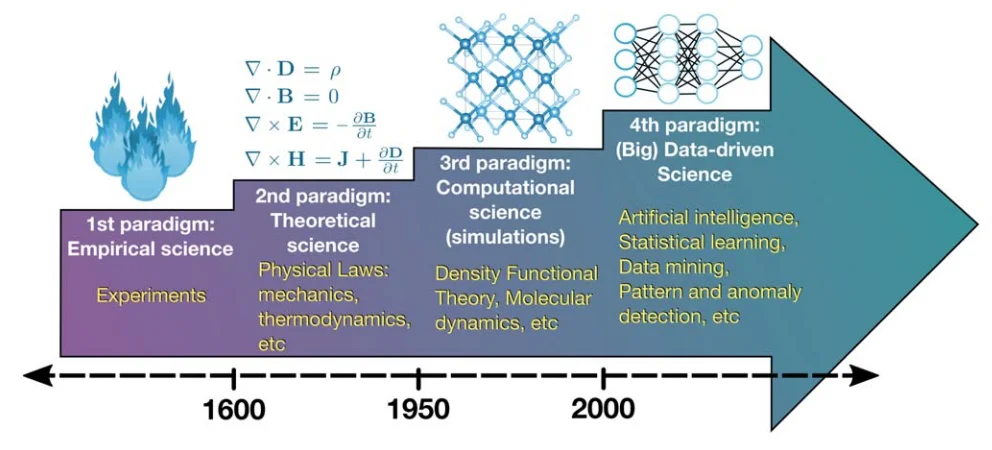Introduction: The role of computational tools in materials science
Materials science is a field that focuses on the study of the nature and properties of materials and how they can be used in various applications. Over the past two decades, the field has undergone tremendous growth, and this is largely due to the advancements made in computational tools and artificial intelligence (AI). In this post, we will explore how computational tools have shaped the field of materials science from the 80s to the present day.
First-principles simulations
In the 80s and 90s, computational tools in materials science were limited to theoretical calculations and first-principles simulations such as molecular dynamics and quantum mechanics. These first-principles simulations assisted the researchers to study the structure and properties of materials -such as thermal conductivity, elasticity, and surface energy- through atomic and molecular modelling. However, these simulations were very time-consuming and required a lot of computing power, making them feasible only for slightly complex systems and accessible only to a few privileged researchers with access to specialized equipment.
Later in 2000s, as computational power increased and computer hardware became more sophisticated, researchers were able to perform more advanced simulations. This allowed them to study a broader range of materials, including those with more complex structures. In addition, the development of new algorithms and software made it possible to perform simulations more quickly and efficiently.
Rise of artificial intelligence
One of the key advancements in materials science over the last decade was the development of machine learning algorithms. From approximately the mid-2010s onwards, the integration of machine learning with first-principles simulations enabled the analysis of larger amounts of data and the execution of more efficient calculations and predictions about the properties of materials.

From DFT to machine learning: recent approaches to materials science–a review (Schleder, 2019)
In recent years, the use of AI has become increasingly prevalent in materials science, as we described in a previous post. AI algorithms have been used to design new materials, predict the properties of materials, and even synthesize new materials in the laboratory. This has revolutionized the field, as researchers are now able to study materials in ways that were previously impossible.
Applications of artificial intelligence in materials science
One example of the use of AI in materials science is the development of predictive models for the properties of materials. These models can be trained on existing data and then used to predict the properties of new materials. This allows researchers to save time and resources by identifying which materials are most likely to have the desired properties before conducting extensive experiments.
Another area where AI is making a big impact is in the design of new materials. AI algorithms can be used to search through vast libraries of materials data to find combinations of elements that have the desired properties. This has led to the discovery of new materials that could not have been found using traditional methods.
Finally, AI is also being used to synthesize new materials in the laboratory. AI algorithms can be used to optimize the conditions under which materials are synthesized, leading to more efficient and effective synthesis processes. This has the potential to greatly reduce the time and resources required to develop new materials, making it possible to bring new materials to market more quickly.
Conclusion: computational tools have transformed materials science
In conclusion, the evolution of computational tools in materials science has been nothing short of remarkable. From theoretical simulations in the early 2000s to the use of AI today, these tools have transformed the field, making it possible to study materials in new and innovative ways. The increasing use of AI in materials science will undoubtedly lead to even more advancements in the future, making it an exciting time to be involved in this field.
References
- Butler, K. T., Davies, D. W., Cartwright, H., Isayev, O., & Walsh, A. (2018). Machine learning for molecular and materials science. Nature, 559(7715), 547-555. https://doi.org/10.1038/s41586-018-0337-2
- Li, J., Lim, K., Yang, H., Ren, Z., Raghavan, S., Chen, P. Y., Buonassisi, T., & Wang, X. (2020). AI Applications through the Whole Life Cycle of Material Discovery. Matter, 3(2), 393-432. https://doi.org/10.1016/j.matt.2020.06.011
- Schleder, G. R., Padilha, A. C. M., Acosta, C. M., Costa, M., & Fazzio, A. (2019). From DFT to machine learning: recent approaches to materials science–a review. Journal of Physics: Materials, 2(3), 032001. https://doi.org/10.1088/2515-7639/ab084b


